#Color Pie
Explore tagged Tumblr posts
Text
The Color of Hope: Ambition, Necromancy, and Black Mana
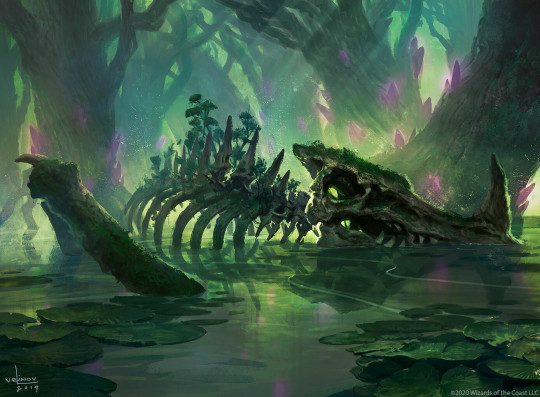
Black is one of the most misunderstood colors in Magic: the Gathering, not least because it appears on the surface to be so straightforward. Look at the most iconic black cards of Magic and you'll see deals with demons, necromancy, mass destruction and cruelty and suffering–the trappings of classic fantasy evil. Even the color's symbol itself is a skull, a universal signifier of death and danger.
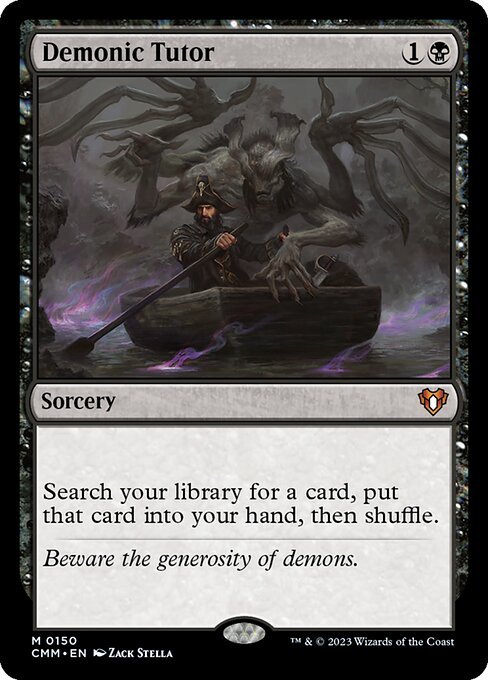
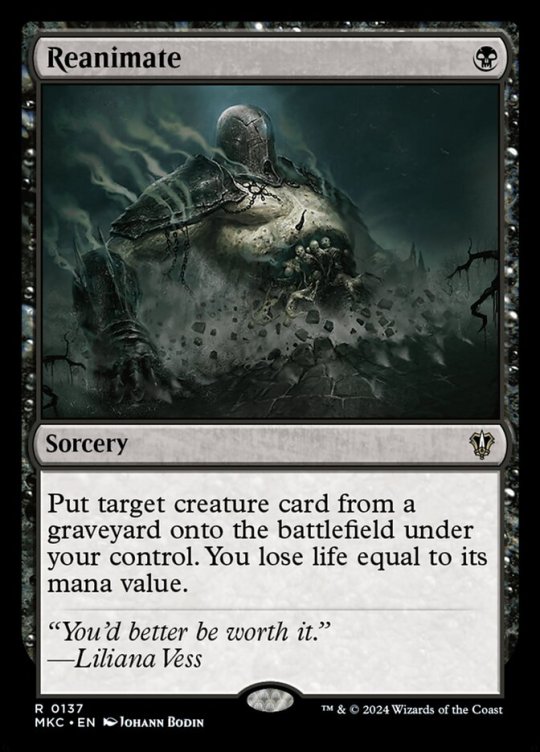
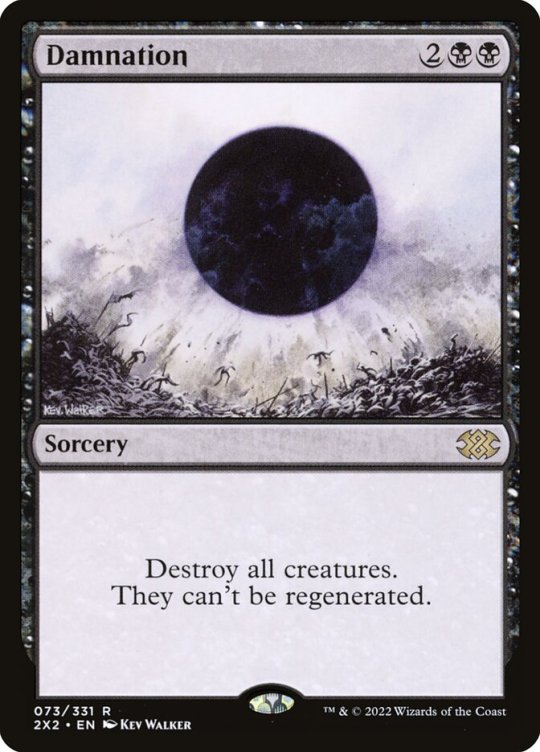
And in early Magic that seemed to be all it was. White was the color of Fantasy Good, black was the color of Fantasy Evil, and the rest of the colors were... fire magic? Elves? Whatever odd but intriguing skeleton affairs are implied by Time Walk?
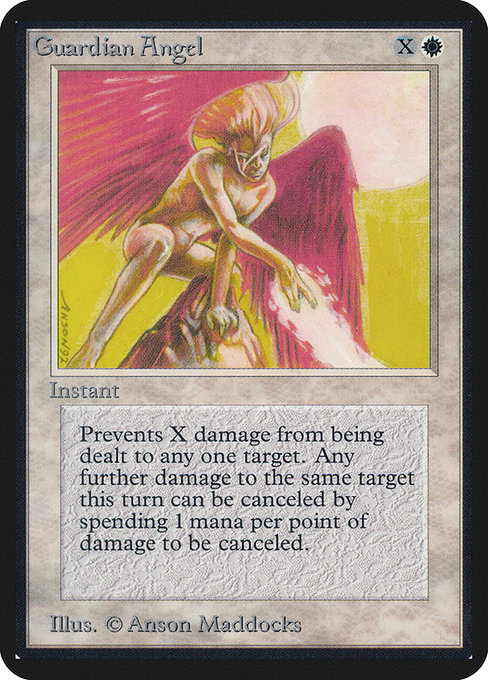
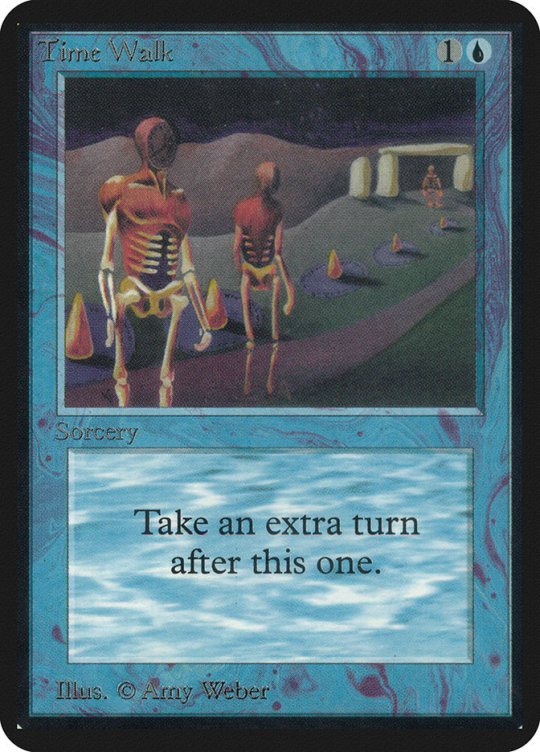
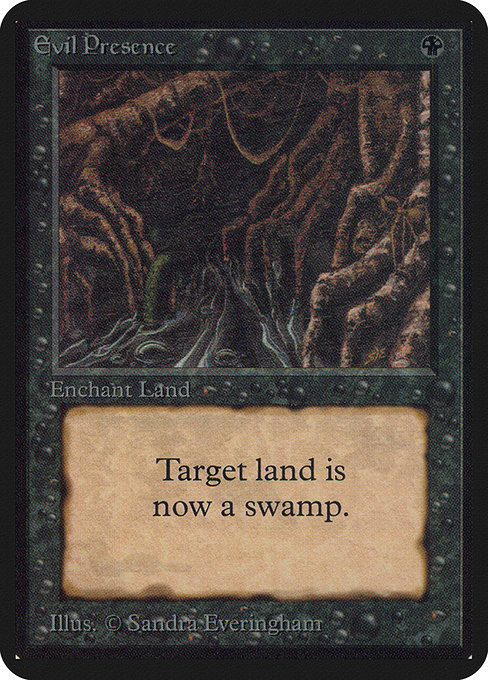
Gradually, though, Magic deepened as both a game and a storytelling medium. The color pie grew into itself as a system of complementary philosophies, archetypes whose associated aesthetics were only part of the full picture. Their arrangement around the wheel, below, is highly deliberate; neighboring colors are said to be allies with a high degree of philosophical and mechanical overlap, while colors on opposite sides of the pie are known as enemies, more likely to disagree on fundamental levels.
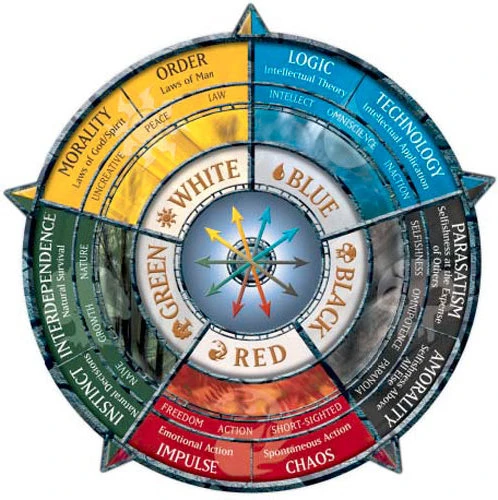
Black stopped merely representing capital E Evil and became the color of striving for power; unlike its peers, black felt that nothing, least of all morality, could prevent it from seizing what it wanted. Mark Rosewater's 2015 article about black emphasized the color's focus on the self:
"Black's philosophy is very simple: There's no one better suited to look after your own interests than you... Many costs require the sacrifice of others for your own advancement. Because it puts itself first, black is always willing to make this trade. The weak must fall for the strong to thrive." -Mark Rosewater
At its worst, black is an exploitative, amoral color that prioritizes itself at the expense of all others, allowing the "weak" to fall and scorning the very idea of compassion. Rosewater writes that black is "always willing" to trade others for itself. And these can certainly be parts of black's philosophy, when taken to its worst possible extremes, but they're far from the entire story.
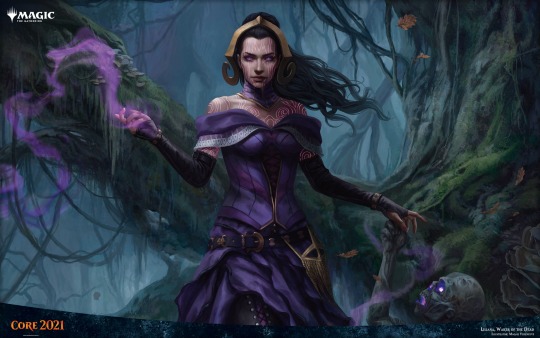
Over time, Magic's outlook on black gained nuance. Magic story introduced protagonists like the necromancer Liliana Vess, whose craving for immortality, seemingly exploitative nature, and demonic deals called back to the oldest portrayals of black–and yet she was not one-dimensionally evil. She underwent character development over the years, learning the value of reclaiming herself and standing beside others, and at no point did she become any less mono-black for it. Remember her; we will come back to Liliana and her story later.
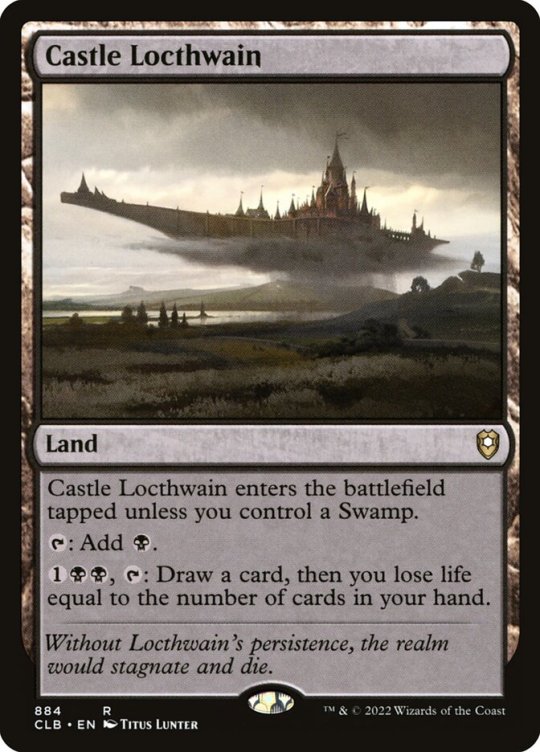
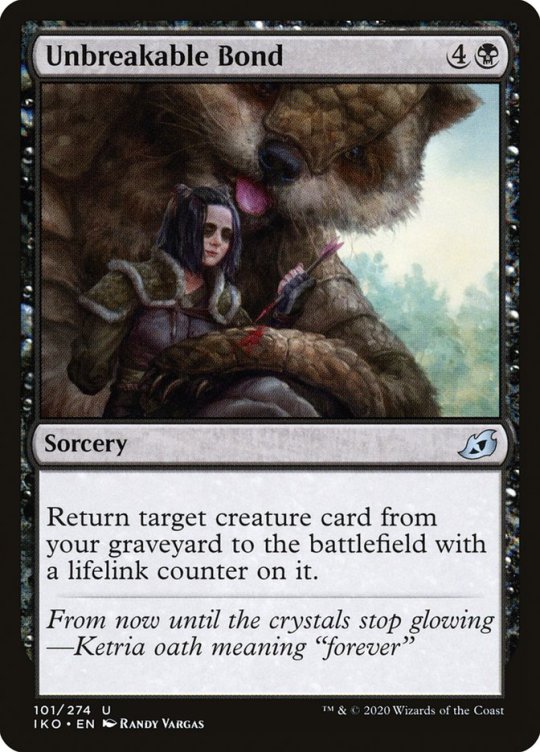
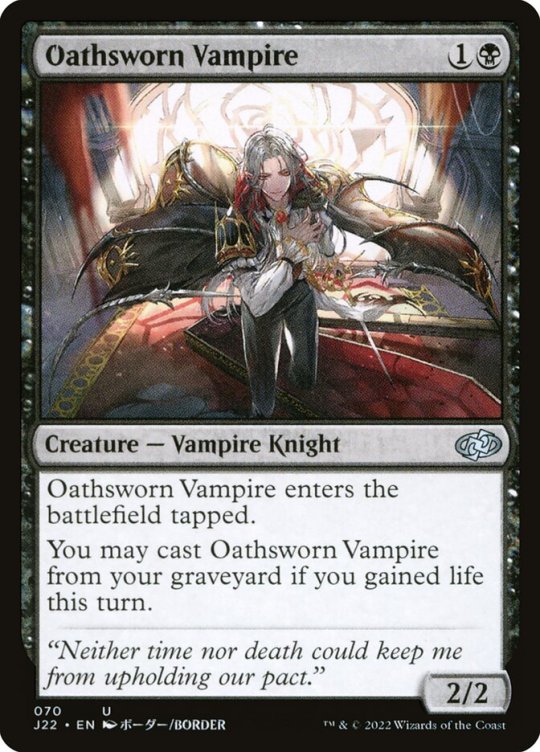
In addition to the usual death and decay, black cards began to feature a theme of relentless devotion. On the plane of Eldraine where each color represents a virtue, black's is persistence, explicitly as important as any other color. On the plane of Ikoria, the love between bonder and beast pulls Winota back from the brink of death. Wherever this Oathsworn Vampire printing is set, its flavor text is quintessentially black. It's the same self-driven attitude as before, but cast in a different light: black is nothing if not persistent when it's got its heart set on something (or someone) it cares about. Nothing, least of all the grave, will keep it down. After all, black will always come back for its own.
These newer cards uncovered the true face of black as a color capable of both great love and harm (sometimes even the latter for the sake of the former), and suggested a tantalizing new thread: perhaps putting yourself and yours first isn't all that bad, necessarily. Black is a deeply protective color; it says you don't just have to accept what you're handed, it's okay even to be furious about it (hello, ally color red), but let that galvanize you to do something about it.
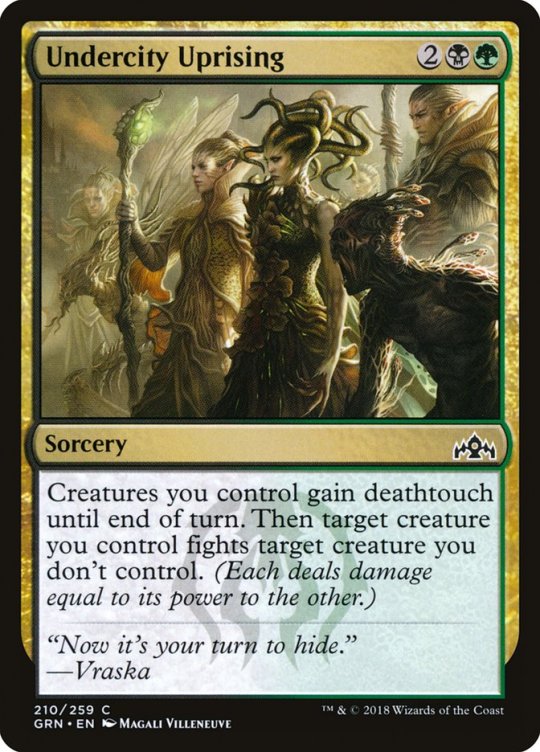
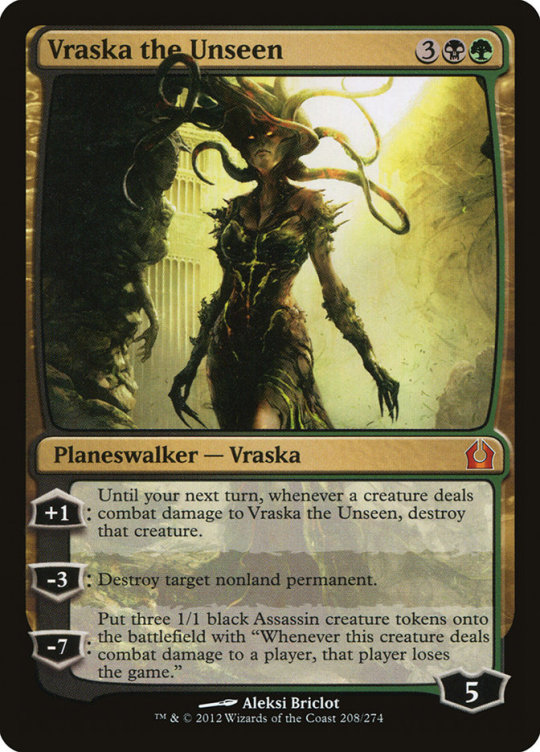
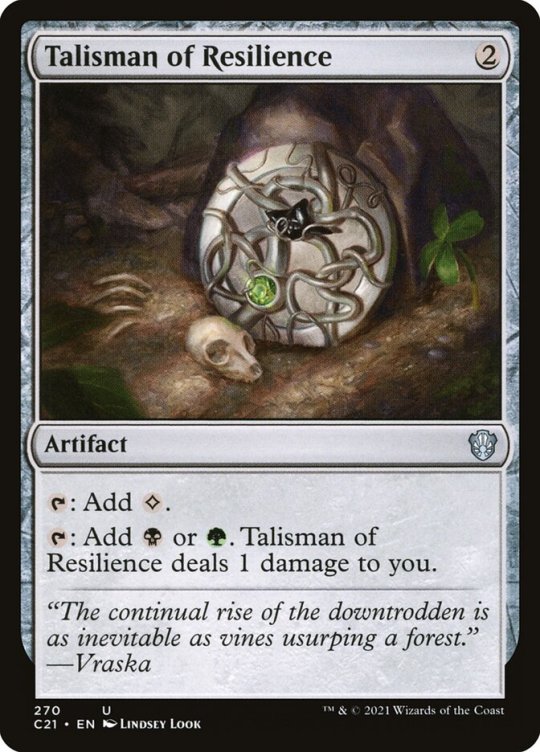
Vraska, a gorgon who faces extreme discrimination on her home plane of Ravnica, triumphs by reclaiming herself, gorgon powers and all–and even more radically, loving herself. She displays traits often considered the purview of white and green, such as a love of home and a drive to elevate the oppressed, but they are all filtered through the lens of her black alignment. Vraska staunchly refuses to deny herself or her people, the Golgari Swarm, of their value. Nor does she allow law or propriety to prevent her from championing them by any means necessary–even if that means cold-blooded murder, or aligning herself with a villain like the Planeswalker Nicol Bolas.
"[Vraska] thought of Mazirek, of the kraul, of the rest of the Ochran assassins and the malignant Jarad who reigned with casual ruin over the most downtrodden of the downtrodden. She remembered her years of isolation, and the heinous cruelty of the Azorius, and how no group deserved to suffer as much as those who would subjugate her own. Eliminating that hell was all she ever wanted." -The Talented Captain Vraska, Alison Luhrs
Like Vraska, black loves fierce and hard, willing to break any taboo for the sake of those it cares about. And it whispers, the entire way through, you are enough. You deserve better. No matter what others may say or do, you are enough.
"If I am to be met with disrespect, then I must first love myself with a fierceness no fool can take away." -Vraska in Pride of the Kraul, Alison Luhrs
Even black's "ruthlessness" isn't as fundamentally cruel as it appears, centering a passion for problem-solving (shared by its other ally blue) instead of a blunt disregard for others.
"People don’t understand the word ruthless. They think it means 'mean.' It’s not about being mean. It’s about seeing the bright, clear line that leads from A to B. The line that goes from motive to means. Beginning to end. It’s about seeing that bright, clear line and not caring about anything but the beautiful fact that you can see the solution. Not caring about anything else but the perfection of it." -K. A. Applegate
All of this comes together to make a black a color not of evil but of strength, integrity, and persistence. And that's all well and good, but I'm going to take it even further and put forward a new proposition: that black is the color of hope.
Of the nine mono-black Magic cards with "hope" in their names, all but Liliana portray black as an instrument of hope's destruction. This is, once again, black's flaw taken to its extreme–crushing others to achieve its own ends–but neglects black's own relationship with hope.

Black, more than any other color, requires hope to stay alive.
For black to persist, it must believe in a light at the end of the tunnel, a future in which its goals are realized. As long as it does, it will endure any hardship, walk through fire, and turn reality itself upside down on its way there. Primal, desperate ambition is the engine of hope that burns at the heart of black, keeping it always one step ahead of stagnation. Bitter and stubborn, black believes tomorrow will come because there is no other choice. After all, for black to relinquish hope is to let itself wither, regress, and die–an unacceptable outcome.
Thus, it is monumentally difficult to strip black of hope. That only makes it all the more crushing when it happens, when black contends with the idea that there is nothing it can do.
Black's deepest, darkest fear is helplessness.

Like any mono-black character, Liliana Vess is driven at her core by a seething, desperate hope. When Liliana first unlocks her necromantic power, it is out of a sheer refusal to allow her ill brother Josu to die, even when the esis root that would cure him is destroyed by enemy witches in an undead-raising ritual. She defies her previous training as a healer, which taught her only to take the safe path, in favor of a higher-risk and higher-reward approach: stealing life from the witches themselves to restore power to the esis root she needs. It is her knowledge that her brother needs her, and her sheer stubborn will to succeed, which allows her to defeat the witches against steep odds.
"Six foes, and Liliana stood alone. But Josu's life depended on her, and the power blossoming within her was more than enough." -Liliana's Origin: The Fourth Pact, James Wyatt
Tragically, however, Liliana's attempted cure goes horrifically wrong, transforming Josu into an undead being plagued by eternal suffering. In his pain, Josu attacks Liliana. For a while Liliana holds out hope, finding the power to fight back while she determinedly searches for a spell to reverse the harm she's done. It is when she realizes this isn't possible that her strength falters.
"All this time, she had believed… that she could turn the power of death to the service of life and health. That a healer should use every tool at her disposal. But Josu was the result, a horrible fusion of life and death, and all her spells meant to manipulate the life force of the living could do nothing to harm the dead." -The Fourth Pact
Liliana learns that even her own dark magic, fueled by determination, cannot solve the problem she's created. She discovers the hard limit of her willpower, and the despair of this discovery is what causes her Planeswalker spark to ignite.


At this time Planeswalkers are as gods, immortal and near-omnipotent. Liliana spends decades enjoying this affirmation of her capability before the Mending strips her and all her peers of their power, reducing them once again to mortal mages.
"Then the Multiverse reshaped itself, robbing her—and every other Planeswalker—of the godlike power they once had wielded. Some called it the Mending, as if something broken had been repaired, but to Liliana, it seemed the opposite. It broke her beyond any hope of repair." -The Fourth Pact
Once again, it is Liliana's fear of helplessness and her refusal to accept it that drives her to push beyond the bounds of propriety–this time, to make a pact with Nicol Bolas and four demons to maintain her immortality. It is not enough for her merely to delay death; she requires the security of knowing she is fully beyond its reach, that she will never be helpless before it again as she was with Josu.
"Holding death at arm's length for whatever years are left to me? No, that's not enough. I want to be free of its shadow." -Liliana in The Fourth Pact
Black isn't like its enemy colors white and green, which are superficially associated far more often with hope. Unlike white, it doesn't believe that conviction, justice, and community will bring about rightness. Unlike green, it doesn't trust in the wisdom of the world or the natural order. Black believes that nothing will change unless you make it change; ultimately, black's self is the only one it can trust to bring about the world it needs. In addition, black lacks its enemies' idealism. Instead, it strives to be a pragmatic realist, making a final assessment of defeat all the more definite and crushing.
While white and green are more amenable to finding hope and holding it aloft as a banner, black claws hope desperately to its chest with shredded, bloody fingernails. Every ounce of hope black has, it tore by itself from the clutches of an uncaring world.



Ironically for such a self-driven color, black's fierce hope is the greatest asset it can provide to others–on its own terms, of course. It was Liliana who turned the tide of battle against the Eldrazi titan Emrakul, defiant in the face of cosmic despair. And when Nicol Bolas made his bid to return to godhood, using Liliana's necromancy to command his undead hordes, Liliana finally turned against him. In reclaiming her power, so too did she use it to free her fellow Planeswalkers from Bolas' assault. Her fear of helplessness no longer shackled her to him; agency and autonomy were hers at last.
The triumph of black, its moment of ultimate victory, is the hard-won fulfillment of its hope.



"Do not go gentle into that good night. Rage, rage against the dying of the light." -Dylan Thomas
An aetherborn, railing against the shortness of their natural lifespan, constructs a new body for themself with their own bare hands. An artificer's grief over her lost companion causes her to push invention to its limits. A young girl who loves her brother calls on the darkest of powers to save him. As it turns out, necromancy–that original thematic keystone of black–is only one of black's many, many refusals to let go of love and hope once it has them, even in the face of the ultimate end.
Time and time again, black–in love with life, ablaze with hope–looks the Grim Reaper in the eye and tells it: "Not today."
#mtg#magic the gathering#color pie#black mana#liliana vess#vorthos#literary analysis#war of the spark#magic origins#planeswalker#nicol bolas#vraska#necromancy
856 notes
·
View notes
Text
I don't think anyone who wants to play only Black cards in [Magic: The Gathering] is a bad person, or that anyone who wants to play only White cards is a good person.
I'm going to repeat something that a lot of people probably didn't read about my last, long post about the White and Black Colors of Magic: The Gathering.
====
Back when video game studios weren't terrified of offending anyone, they used to provide "Morality Paths" in their games.
No one lied to you about which path was Evil, or at least Anti-Heroic.
To deny that the Pacifist Route of Undertale was Good and that the Genocide Route was Evil would be to insult your intelligence and rob both paths of any meaning.
HOWEVER, if anyone tried to argue that only "Evil People" wanted to play as evil characters, everyone knew not to take that person seriously.
I don't think that there's anything wrong with someone who only ever wants to play with Black cards.
I only think there's something wrong with a person when they try to tell me: "The Color Black has nothing to do with Evil, and the Color White isn't actually Good".
If someone tells me pepper isn't spicy and salt isn't salty, it only reveals how tasteless they are.
====
Bad people can like playing nothing but White cards because of White's wholesome aesthetics. For the same reason that bad people can like beautiful sunsets, lovely music, sugary sweets, and being trusted and praised by the people around them.
Real people who want to deny that they have any character flaws, or bigoted opinions, or any capacity to do harm or evil will surround themselves with wholesome, clean, cutesy iconography and symbols and associations. This is called "Virtue Signaling".
The most toxic people in the world have the most vested interest in appearing harmless.
Before Harry Potter became a dirty word on the internet, people could rightfully reference Dolores Umbridge, the cruel, petty, paranoid, hateful monster who tried to convince herself and everyone that she was nothing but sweetness and light and righteous.
As a person, Dolores Umbridge would play nothing but White cards and would clutch her pearls to see anyone playing Black cards. She would pretend to faint if she so much as touched a Black card.
Which is funny, because if a fictional character like her were accurately represented as a Magic card, she would be pure Black. She may not have been Dark Lord levels of ambitious, but no one who was pure White could have "inventing instruments of torture" as a HOBBY, let alone take delight in making other people suffer, or pledging allegiance to an actual Dark Lord as soon as he replaces the legitimate government as the ruling power of the land.
Because while Magic HAS to choose Colors that accurately reflect fictional characters, real people can choose Colors that have nothing to do with their personalities at all.
Be honest: In terms of real personalities, Blue must be over-represented in the Magic: The Gathering player-base compared to Red. How many impulsive, athletic 'dude-bros' would rather learn the rules, collect the cards, construct the decks, and sit down to play this game... instead of going outside to touch grass and kick balls around? Or at least playing a video game like Call of Duty.
By the same token, if only bad people played Black cards, almost no one would play Black at all.
Good people can like Black's horror aesthetics for the same reason good people can like Halloween, horror stories, and slasher movies. It can be fun to play the villain!
Games are safe ways to explore our darker fantasies because we're not causing real harm to real people. It's all make-believe.
But it's a Red Flag when someone says, "Actually, the villain is the hero."
Not in the sense that the villain is the protagonist, or the protagonist is an anti-hero fighting a worse person, or the protagonist only looks like a monster, or the protagonist is actually a hero being framed as a villain by an actual villain.
I mean in the sense of, "I think Pennywise the Clown, the child-eating boogieman, is an ally to everything I want to see happen in the world."
Or, "I think the mass-murdering psychopath is a decent fellow as long as he only murders people with a skin complexion I don't like, or if she only kills men."
Or, "Morality is subjective or a lie, there is no truth but power, and there is no inherent, sacred value to all human lives."
#magic the gathering#mtg#white magic#black magic#moral relativism#dolores umbridge#there is no truth but power#color pie
50 notes
·
View notes
Text
Green vs Blue color philosophy

28 notes
·
View notes
Text
I can't overstate how much I love the color wheel (or color pie) from Magic:The Gathering

I started playing magic back in 2001 when I was 14, Odyssey had just come out. I knew a bit of English, and I soon started reading Magic's website for news and spoilers. That's when I discovered @markrosewater 's column Making Magic. MaRo is both a great game designer and an impressive writer, his column was entertaining, witty, fun and informative. I consider Magic and especially his column to be the main reason I learned to read English so fast.
Now, 2001 was a period of transformation in Magic. The main saga in the story had just ended (consider Avengers:Endgame), and the people at WotC were reconsidering and rebalancing the color wheel. I remember there being weeks dedicated to the single colors, and MaRo's comulumn being deeeep dives into those colors.
Now, what's the color wheel? You see, in the universe of Magic: The Gathering the primordial energy and building block is mana, which comes in one of five colors: white, blue, black, red and green. Mechanically, each card is associated to one (or more) colors, and each color has mechanics that are typical for it, like green being the color of growth and big creatures, blue being the color of spells and flying, and black being the color of death and zombies. But the people at WotC put a lot of effort to also distinguish each color thematically, defining *why* each color has certain mechanics, what it says about the color's philosophy and values. Green is the color of nature and community, where the small ones help the big ones grow and foster. Blue is the color of knowledge and artificiality, black is the color.
It's pretty intuitive most of the time, but here's where it gets even better: the placing of the colors on the wheel has a meaning. Colors that are close to each other are "allied" colors and have something in common, while colors that are opposite of each other represent the two opposites on an axis:

I don't have the time (or skill) to go into detail here, but this system is so damn elegant. It has five basix building blocks but allows to represent an incredibly vast array of concepts, characters and behaviors.

The color wheel is still my favourite system to define/describe fictional characters, it's miles better than the alignment chart of D&D (or, like, hogwarts houses).
I find it incredibly fun to discuss what color(s) certain character fall into: is superman white, green? Is batman white, black, blue? A combination of those? Ryuko Matoi is red, Satsuki Kiryuin is white. Do you disagree? Perfect, tell me why, it's always super interesting to see which aspects of a character people consider the most prominent!
My favourite Magic blocks and sets were those playing with the color wheel and its concepts, mainly Planar Chaos but ESPECIALLY Ravnica. Man, I really need to play some rpg campaign set on Ravnica sooner or later.
I played magic for 5-6 years (until I finished high school), but the color wheel is ingrained in my mind. It was the main chitchat topic when I first started going out with my SO more than 15 years ago xD
So yeah, not sure who this is for, it's mainly me rambling and fanboying about one of my favourite game design and character creation concepts. If you don't know the color wheel, I suggest you try to read a bit about it. And if you do know it, what do you think? Is there anyone out there who used it as a basis for an rpg or foe writing?
38 notes
·
View notes
Text
{MTG Color Theory 201:}
Or
2-Color Characters
[if you like, you may also peruse my post on monocolor characters]
With 5 colors available, we have 10 possible combinations of 2. As it happens, this includes 5 Allied Color Pairs (ACPs) and 5 Enemy Color Pairs (ECPs). Grouping them this way will help us understand their motivations, which are either coherent & external (ACPs) or dissonant & internal (ECPs). I’ll get into what exactly I mean by that below.
{for reference}

ACPs (Allied Color Pairs)
Red/Green: The Champion
Green/White: The Martyr
White/Blue: The Authority
Blue/Black: The Manipulator
Black/Red: The Demolisher
ACPs are defined by what their 2 colors agree on. Their ideology a coherent fusion of their color philosophies. They will have 2 Fair Weather Friends, the 2 colors adjacent to them, which they can tolerate but only to a degree; and 1 Nemesis, their shared enemy color, an external motivating force that they stand firmly against.
Vs
ECPs (Enemy Color Pairs)
White/Red: The Enforcer
Red/Blue: The Visionary
Blue/Green: The Cultivator
Green/Black: The Predator
Black/White: The Master
ECPs are defined by what their 2 colors disagree on. Their Ideology is defined by a dissonant tension along a particular philosophical axis. They will be defined partially by their Blind Spot, the single color that sits between theirs, and their Rival Color Pair, the 2 colors opposite their Blind Spot that define what they reject in life.
{dig into the notes}
{see also my Quick Tour of 2-color Paladins}
#MTG#magic the gathering#Color Pie#mtg color theory#characterization#color pairs#character building#writing#troglodyte thoughts#free range sustainable shitpost
226 notes
·
View notes
Text
Counterspells should have limited access in all colors, not just Blue. Don't get me wrong, blue should have it best and probably be the only one with hard non conditional counters, but the fact that if someone casts a Time Warp, or Expropriate, or Insurrection, or Craterhoof, or Armaggeddon, or Stasis, or Cyclonic Rift, or Warp World and if I am not in Blue (or slightly in White) I just have to eat it and hope someone else has a counter seems unbalanced.
Only one color gets to meaningfully interact with an entire card type (sorcery) and it is messed up. Reprieve is a step in the right direction and I think Tibalt's Trickery is the perfect blue print for a red counter if only it couldnt target your stuff.
8 notes
·
View notes
Text
Viktor's Complicated Color Progression to The Machine Herald and his strugles with Black Mana
Viktor is a very complicated character with a myriad of tragedies. To me I think based on his story, his place in the world, his relationship to the color pie pushes Viktor firmly as Yore-Tiller. It is the combo of Artifice. Of innovation, progress, evolution.
Viktor is a scientist at heart, a man of discovery and creation. As a child he tinkers and builds and as an adult he invents and evolves. This is why Viktor's core color is obviously Blue Mana.

Inherently curious about the world.

As he meets Singed he gains structure, a mentor, he sees a purpose in science. Not just finding fun or making toys but cultivation and growth. Even if he doesn’t understand it yet this is the foundation of his connection to White Mana.

Viktor gains a sense of morality, ambition is not worth anything. Not worth harming those you claim to help. Suffering is never justified

“There is always a choice.”

This Azorius state is where I believe Viktor spends most of his life. A scientist with an ethic working under constraints in a very ordered society. Piltover is an Azorius state. One more heavily influenced by Blue than White but Azorius nonetheless. Viktor gives himself completely to Piltover until he meets Jayce.

And then the sickness starts. The Desperation. As Viktor rots so do some of those morals, those boundaries. He steps over his line in the sand. But only he does, he won’t sacrifice anyone else for his ambition or his salvation. He gains a tempered connection to Black Mana.

This is a connection that is wavering, he is desperate and grasping. He is not ambitious enough to truly harness black, he can’t bring himself to harm another for his own gain. He only carves himself apart to gain a future. But then he goes too far, Skye gets killed and he pulls out completely.

When shown the cost Viktor won’t pay.

He lets go of the Hexcore, of Black.
And then he dies.

Here he sits, until his body is healed.
From the tomb he rises. Now he is empowered by the Hexcore, and at first I think he teeters on the edge of Black.
He is lost, aimless and emotionless.


And then the Rebirth, the Evolution. He saves the people he always wanted to help. He is renewed.

He touches Red Mana.

He is passionate about his dream, he is exploring new vistas and ignoring boundaries but not out of a desire to gain but to help. He puts himself in a vulnerable self sacrificing position for Warwick regardless of Skye’s knowledge of the systems limits

“He is worth the risk.”
He fosters a chaotic growth in his commune. A place of change and revolution and peace. A place where the Jeskai colors flourish. However there is no place for Green Mana here. At least not for Viktor. Viktor seeks to evolve and as he puts it,

“Evolution’s purpose is to supersede nature.”
Not a very Green ideology if you ask me.
This leads us to the Hammer of Damocles above Viktor.

Jayce.
Jayce for whatever reason (my theory on why is far too long to get into but basically Jayce is creating the future he saw by mistake, tragic consequences, three times the charm, etc.) decides that Viktor and what he has built needs to die. Regardless of if he was correct (I don’t believe he was for aforementioned reasons I won’t get into.) or not he has done damage. There is no going back.
Whether because of Singed or as I hope his own desperation, ambition, and need to evolve will push Viktor to his final state. This is when he will finally grasp Black Mana.

He will touch the Void, let go of his humanity and seek only progress. He gains the ambition and the stomach for violent action. Viktor was not born with power, he wasn’t handed power, no, as Silco once described Viktor must now take power by any means necessary.
To herald a new age, a new world.
To bring about the Grand Evolution.
#viktor#viktor arcane#arcane spoilers#mtg#magic the gathering#color pie#hes complicated ok#jayce has a similarity complicated progression#jayce is jeskai but i think has a grixis phase#heimderdinger is also jeskai#jinx is a compicated grixis#vi is ghruul#ekko is temur or inktreader but i like temur#cait is azorius but has a fascist esper phase#mel is mono white and mbessa is jund or dunebrood#silco WAS mardu and vander WAS naya#sevika is jund#warwick is jund too#singed is sultai#i think thats everyone important#dont judge my ideas#most are not very confident but i can explain any of them at least somewhat#edited for typos#arcane#arcane season 2#arcane jayce#arcane viktor
10 notes
·
View notes
Text


I love her I N F I N I T E L Y
Incidentally this card, like every Huatli card, embodies an under-appreciated archetype of RGW color alignment—the interest in human unity of GW, infused with R’s artistic passion!
52 notes
·
View notes
Text
Red
Magic the Gathering (MtG) is a card game created in 1993 that has continued into the modern day. While much of its success can be attributed to creative ideas in world building, gameplay, and characters, pieces of it are hinged on one of the games core concepts: the “Color Pie.” In Magic, every card is grouped into one of a few categories: White, Blue, Black, Red, Green, Colorless, and…

View On WordPress
#ADHD#art#atarka#boros#color#color explained#Color Philosophy#color pie#color pie magic#color red#creation#destruction#Discussion#Emotion#grixis#gruul#haste#Homer#homer simpson#izzet#jeskai#jund#kolaghan#Life#m#mabel#mabel pines#Magic#Magic Card Game#magic mechanic
8 notes
·
View notes
Text
Corrupt Judges as Magic the Gathering colors
White: This judge is loyal to their nation or ideals, but said nation or ideals are similarly corrupt. A white judge is the judge most likely to persecute the marginalized, the downtrodden, the unfortunate due to their own corrupt values. Anyone considered a "degenerate" in their society would not be safe from them.
Green: This judge would believe that they are the arbiter of fate, that the natural order made for them to be a judge and therefore they are the natural order, at least in their own courtroom. Anyone who they believe fate doesn't favor would not be safe from them.
Red: This judge would not care about the logistics of any court case, only their own emotional understanding of them. The letter of the law matters little to them, making them... unpredictable, to say the least. Ironically, they're the ones most likely to let people go, but for all the wrong reasons. Anyone who can't appeal to them would not be safe from them.
Black: This judge is the one most loyal to themself and themself alone. A black judge can be bought with money, pacts, whatever that benefits them the most. They're also the one most likely to make Faustian bargains with others, whatever benefits them most. Anyone who runs counter to the judge's interests would not be safe from them.
Blue: This judge would be the one to adhere closer than any other to the letter of the law, but in the process would completely disregard the spirit. A blue judge is the most rigid in the legality of any situation, and therefore the most likely to condemn defendants on a technicality, because to them the law is never wrong. Anyone who is technically illegal would not be safe from them.
10 notes
·
View notes
Text
A similarity between green, red, and black on the color pie that I really appreciate, and that people often overlook, is an implicit trust in the self.
We see this most clearly in red and black, which center upon the self and personal needs or desires. Red is all about pursuing freedom, allowing yourself to feel your emotions, and acting upon them. To red, the opinions of others are a hindrance at best and a life-stealing prison at worst. Black is often about holding onto and prioritizing yourself, even when the world tries to force you not to. In extreme cases, it believes you are the only person you can trust in a cutthroat world that tries to bring you down. These are the two colors most often maligned in a society that favors the collective status quo over the needs of the individual, and conformity over diversity.
Green is often placed in opposition to these two "rebellious" colors as a preserver of the status quo. Almost every description of green philosophy includes some variation of the word "tradition" and an assumption that the color innately opposes change and progress. At worst it's characterized as a staunch traditionalist with a stagnant worldview who lashes out against progress of any kind, and sure, that can certainly be one extreme manifestation of green's flaws but it's by no means universal or inherent to the color.
Far more fundamental to green's philosophy is the idea that strength, power, and capability come foremost from within. It is, I'd argue, the core of green's worldview. Others' wisdom may guide you to unlock these things, and you can't separate your own power from that of the community around you, but it's still ultimately your job to discover what you are capable of. The path to victory is never walked alone, but only you can truly know yourself, in the end; only you can give yourself the strength you need to succeed.
And there lays green's unlikely overlap with red and black--its faith in the ultimate power of the self. (There are certainly other similarities, but this is an important one.) It's less evident in green because the "self" aspect of red and black is so often defined in opposition to others, while green is far more community-minded, but an underlying fierce faith in self-knowledge remains.
White and blue believe that true direction comes from beyond the self, whether that's from established morals or empirical research. Meanwhile, green, red, and black all insist that you are enough already; you alone know yourself, your needs, and your capabilities best. Embrace it.
#preview on my color pie thoughts before i put out the black mana essay#mtg#magic the gathering#red#green#black#jund#color pie#vorthos#green mana#black mana
102 notes
·
View notes
Note
That “Hazbin Hotel-ification of the Colors in Magic” thing you brought up I think could be more appropriately called the “Game of Thrones-ifying” of it and the modern fantasy genre more broadly as I feel that’s where this obtuse obsession with the “There are no real heroes and villains, just subjective worldviews with no actual moral weight” thing came from. Seriously, I’ve come to genuinely DESPISE ASOIAF for opening the floodgates to the nihilistic sludge we’re trudging through now.
You inspired me to crawl back through my tags to find this post in particular, about how Millenials (women in particular) kept rewatching the Lord of the Rings movies for comfort. "Because the good guys are actually all good."
There was no mention of George Martin's work in the version I reblogged, and I've never read ASOIAF, so I didn't make a connection at the time.
I also found feynites' post about: "People are confused by the fact that the villains are unquestionably villainous."
And another post about how almost all of Tolkien's imitators treat "Good" and "Evil" as equal opposites that simply see-saw between which has the advantage at any time, but Tolkien himself presents Good as the root of everything and Evil as a disease and corruption which did not exist in the beginning and will not endure to the end.
But, possibly, what we are seeing might also be a result of Phillip Pullman's assault on The Chronicles of Narnia through the His Dark Materials books.
Pretty sure Hollywood found it more financially affordable to make more Narnia movies than Materials movies, at least until Hollywood couldn't stomach Lion Jesus any more.
#lord of the rings#lotr#tolkien#hazbin hotel#a song of ice and fire#george martin#game of thrones#asks#ask#magic the gathering#color pie
16 notes
·
View notes
Text

What if the mtg color pie was people?
34 notes
·
View notes
Text
On my generalized assessment of the Magic The Gathering color pie after playing for a few years:
Blue: do non-creature things with no downsides
Black: do everything but with all the downsides
Green: do creature things with no downsides
Red: do everything but it's slightly weaker
White: do everything but in a roundabout way
2 notes
·
View notes
Text
MTG COLOR PIE
2 and 3 color characters
[my core post on MTG COLOR IDENTITY]


So. This post is gonna get long. Might take me a minute. Buckle up.
Every color pair is either Allies or Enemies, depending on whether or not they sit adjacent to each other on The Star. This profoundly affects how the character motivates themselves and needs to be kept in mind whenever adding colors.
• Allied color pairs agree in vague terms about what is important, but tend to differ in specifics when you start digging into the definitions of the things that they value. The act of refining their understanding of what they care about is their main method of acquiring an additional color.
• Enemy color pairs disagree along one of their major philosophical axis, so in order for a character to embody both, they must experience some tension along that axis. The act of resolving that tension is the main way for this character to acquire an additional color.
Similarly, 3-color characters can be broadly categorized into Shards & Wedges, depending on whether or not all the colors are adjacent. They will have a Nemesis Color Pair, the 2 colors they do not include, which can be helpful to pay attention to while fleshing the character out.
• Shards are triplets that are all together on one side of The Star, with no gaps. They superficially resemble a monocolor color of their central color, but have integrated elements of their Allied colors, usually in pursuit of more firmly distancing themselves from the center point between their Allied Nemesis Colors.
• Wedges, conversely, are triplets wherein one of the colors is isolated from the other two. The most complex of the available options, any character that winds up here took a turn somewhere along the way. I’ll unpack that later.
48 notes
·
View notes
